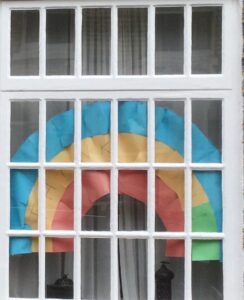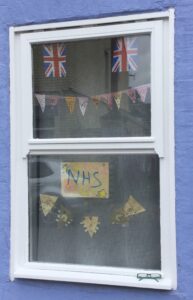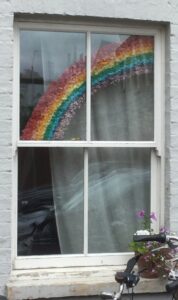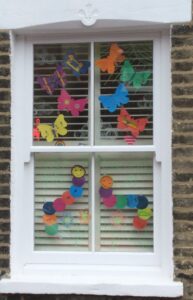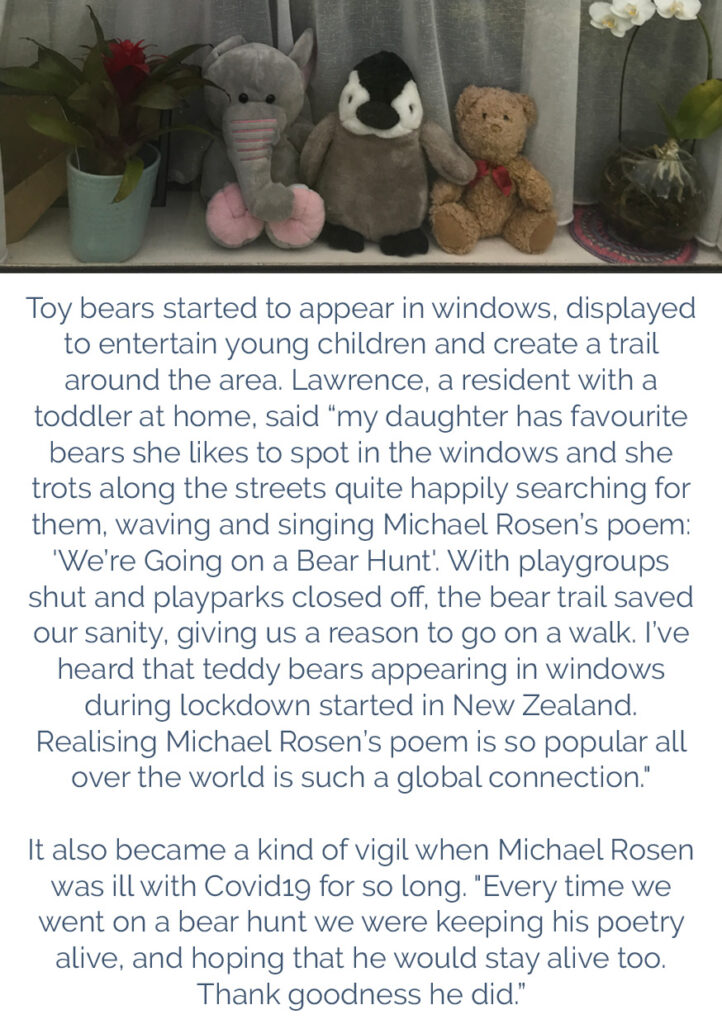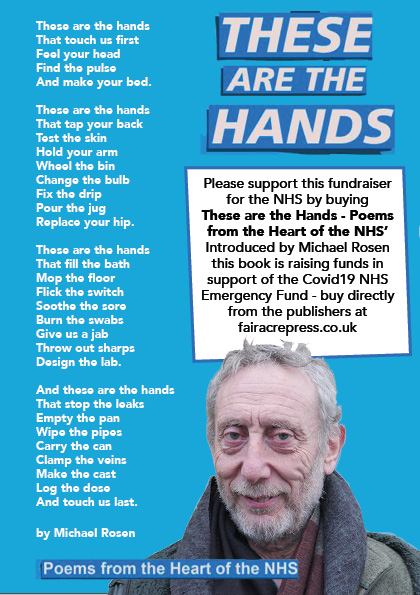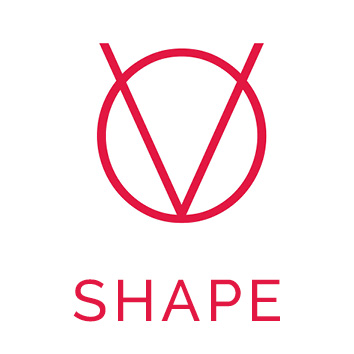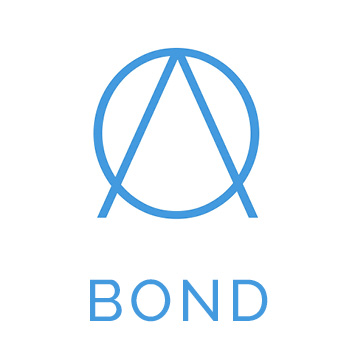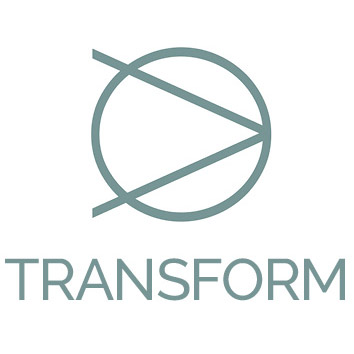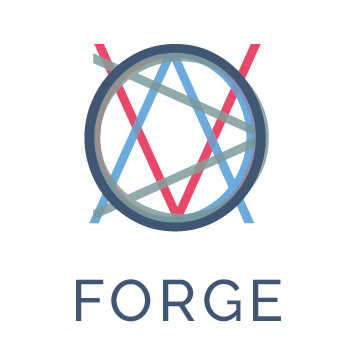Support and Solidarity
Communities have bonded through shared support networks. Our homes and streets have been decorated as we have found other ways connect to neighbours – spreading joy and displaying messages of thanks and solidarity. “It’s like we all feel bit more vulnerable and more aware of inequalities,” said local resident, Bee Wilson. “People are thinking more about fair play. For many years there have been families going hungry during the school holidays, but now more people seem aware of it, care about it, and want to do something about it.” Whether it was vulnerability making people feel more compassionate about inequalities, rage, or the collective feeling both locally and globally that enabled people to have a voice, 2020 has been a year of campaigns, acts of kindness, creativity and hope.
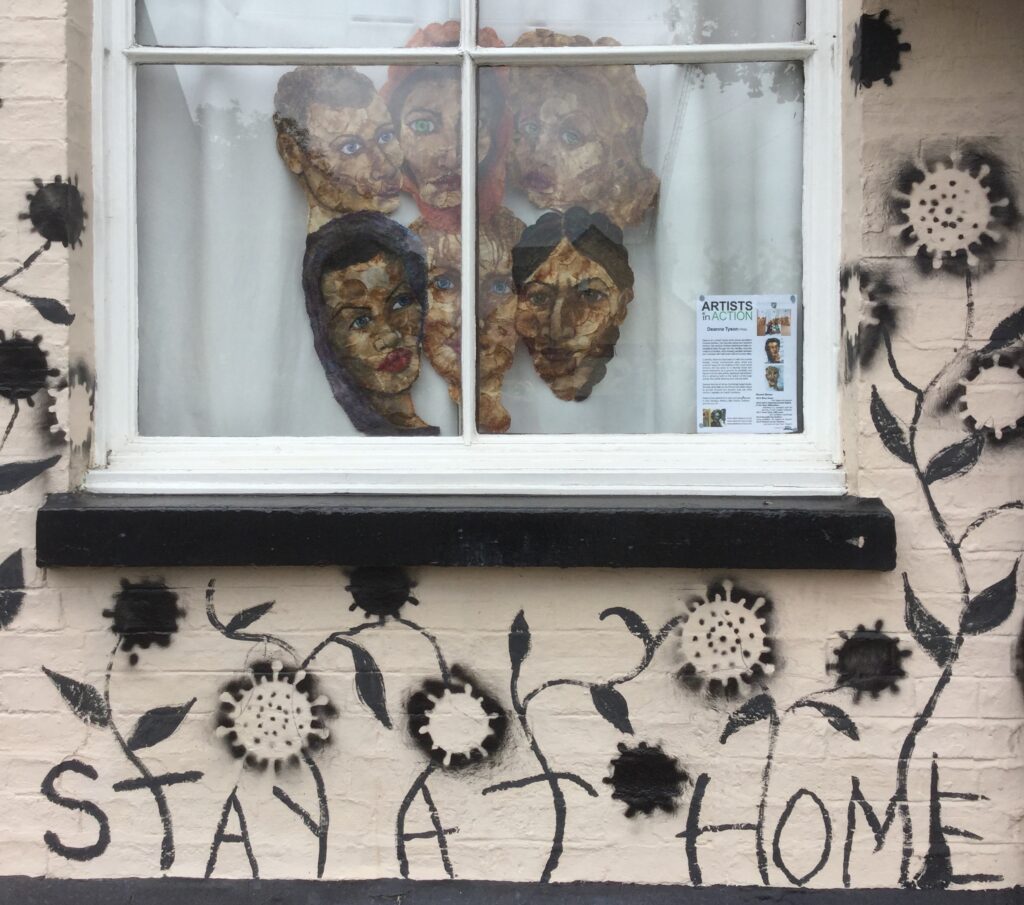
The Geldard Pub. Artwork by Deanna Tyson.
‘While the crisis deepened, solidarity actually bloomed. There’s been an explosion of altruism and cooperation: people singing from balconies; neighbours collecting food; volunteers sewing masks; doctors, nurses and cleaners risking their lives on the front lines… In a time of extraordinary challenges, when Covid-19 seems like just the prequel to the global climate crisis, we need to assume the best in one another. As a historian, I can’t say I’m optimistic, but I am hopeful because hope impels us to act.’
Rutger Bregman, historian and author of ‘Utopia for Realists’ and ‘Humankind’.
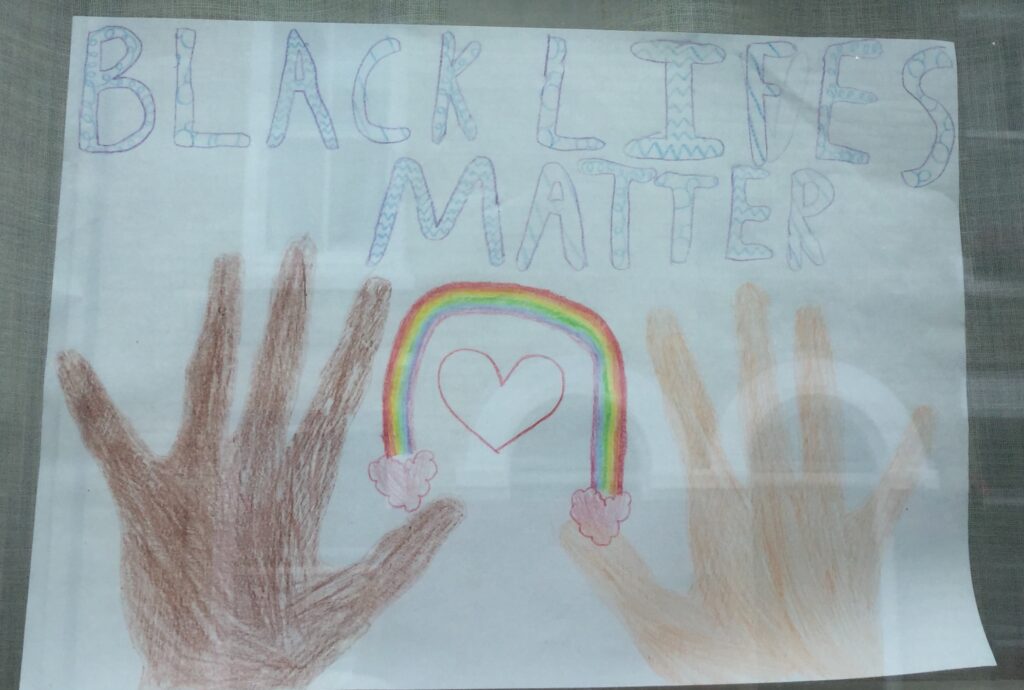
Photos of windows around Sturton Town and Mill Road by Hilary Cox Condron
“It has been heart-warming to see pictures children and adults have placed in windows and on their houses. Rainbows have become an international emblem of hope. Many rainbows have been made by residents in Sturton Town, displayed in the form of drawings, paintings, collages, flags, mobiles, and toy bears started to appear in windows.” says Helen.
Local musician, Andy, describes the reaction to a local campaign supporting the ‘These are the Hands’ NHS fundraiser, also by Michael Rosen, as residents shared posters of the poem through WhatsApp groups, printing it out to display in their windows. “As people came together to clap for our NHS carers and key workers, in some streets they started to clap out the rhythms, and play it on pots and pans, an amazing sound to hear an entire street, clapping out and chanting the first lines of this poem together.”
Sturton Town and Mill Road have a long history of inspiring campaigns for social reform, both locally and globally.
EGLANTYNE JEBB: ‘A TRULY INSPIRATIONAL VICTORIAN’
Eglantyne Jebb, the social reformer, economist and political activist, lived in Cambridge and campaigned for better sanitation and housing conditions in the early 1900s. She was a truly inspirational Victorian.
Helen Weinstein has been researching the original documents. Eglantyne Jebb was a woman of her time, campaigning for better life expectancies for working families and children and joining the suffragette marches. Impressively, she campaigned beyond England by going to the Balkans during and after the First World War and supported refugees in the aftermath of the war, particularly child refugees. Eglantyne became an expert on the plight of displaced and unaccompanied children, which inspired her to campaign for the rights of children and on to founding Save The Children. Her determination to change the world for the better did not stop there, and her most important achievement in terms of safeguarding child protection, which still has resonance today, was in 1924 when the League of Nations endorsed her Declaration on the Rights of the Child.
Eglantyne, Cambridge and Florence Ada Keynes
“Eglantyne Jebb came to Cambridge to live with her mother in 1900. She had been a pioneering student at Oxford and wanted to be of use in Cambridge, so volunteered to work for the charity organisations supporting those who were suffering because of poverty – much of it caused by epidemics of cholera and typhoid and smallpox, tuberculosis and diphtheria,” says Helen. “Borough records for public health show that the officials on the ground were doing all they could to suppress contagious diseases and their oversight was even more detailed than we have during Covid track-and-trace; for example, they were able to pinpoint an epidemic of 1888 to a specific household on Sturton Street itself.
However, this was before the welfare state and the funding of the National Health Service, so Eglantyne’s work was voluntary, using charitable funding to support people in need, donations and loans in order to be paying medical bills or dealing with unemployment. It was these cases that gave Eglantyne Jebb not only research data but insights into the issues of poor sanitation and the impact of poverty.”
Eglantyne was mentored by another inspiring social reformer, Florence Ada Keynes, one of the early graduates of Newnham College, was very involved in the founding of the CCOS, Cambridge Charitable Organisation Society. It was through collaboration with CCOS charities that Eglantyne came to work in the dense urban housing in the neighbourhoods close to the market place and the castle, leading her to Sturton Town to evaluate charitable cases close to Mill Road.
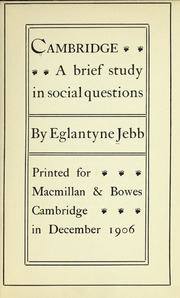
Another mentor, Mary Marshall, (co-founder of Newnham College, and a lecturer in Economics), coached Eglantyne to write up her research, which became a ground-breaking survey of poverty in Cambridge: Cambridge: A Brief Study in Social Questions published in 1906.
Eglantyne describes the poor conditions and sewerage systems in Cambridge in the Victorian Era. The residents of Sturton Town were aware that they needed improvements and petitioned for mains sewerage connections as far back as 1879. But many in the University were shocked at reading this research publication, as they were ignorant of the inequalities directly on their doorstep. Eglantyne had highlighted the poor living conditions of families in the rental housing sector, of overcrowding and the lack of proper sanitation and drainage in many areas, including newly built ones like Sturton Town, and she documented the resulting epidemics from multi-generational and crowded living conditions.”
The Cambridgeshire Archives in Ely include the kind of cases Eglantyne was using to research her book. Helen observes “It has been really shocking to read some of the cases that Eglantyne would have encountered in the CCOS, Cambridge Charitable Organisation Society. Families who had steady jobs as policemen or bakers or brewers could need financial help when they had huge bills to meet from having a sick child in their family; or rent to pay when the industry they worked in folded in days, such as the fossil diggers and coprolite millers whose industry suddenly went into crisis and closed in the late 1880s. The case of a loan of £5 to Sarah Elizabeth Brown, a relative of the Headly family who was living in Sturton Town, is particularly shocking.”
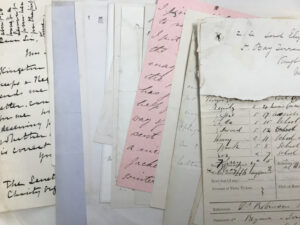
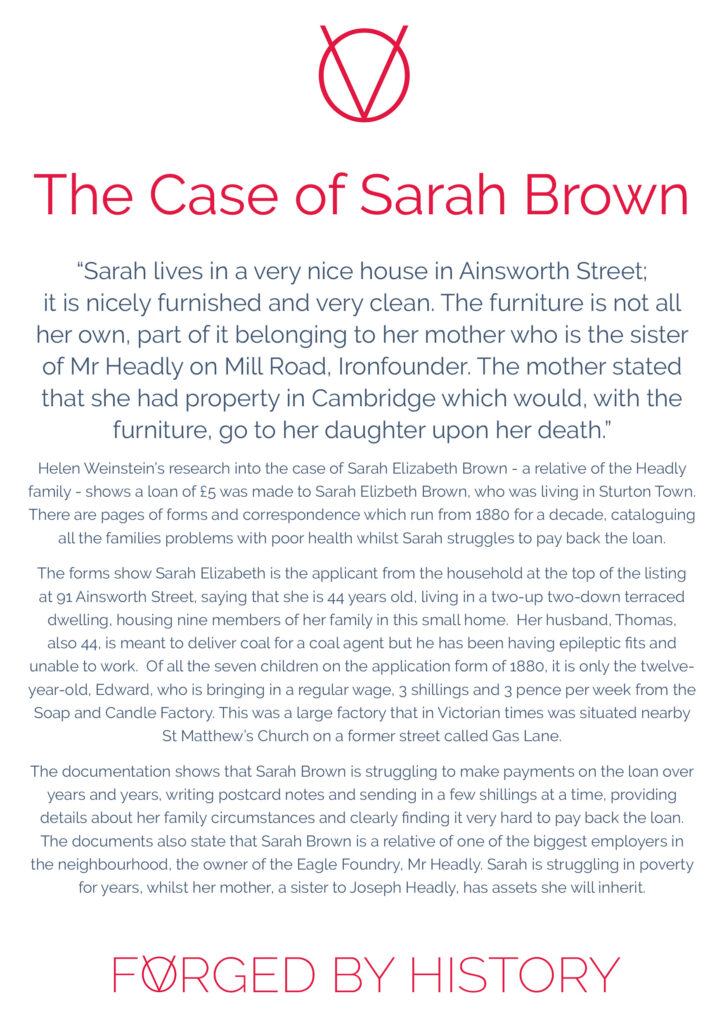
FORGE 2020 at The Museum of Cambridge
These are the kind of charitable cases, of which there are over two thousand, Eglantyne Jebb would have studied for her book documenting poverty conditions in the Victorian era. They really do have a powerful resonance today, showing that families who had good jobs can become economically dysfunctional once key wage earners become too sick to work or become unemployed at no notice, with rent to pay, fuel and light bills, and food to purchase to feed their children. Cambridge is still ranked as the most unequal city in the UK. (A report by the Centre for Cities).
FORGE Pop-Up Exhibition at The Museum of Cambridge 17th December – 8th February
Upstairs in the dining room the Cabinet of Inspiration celebrates local stories of pioneering thought and social justice. as well as sharing inspirational images taken during the pandemic: the first Black Lives Matter demonstration on Parker’s Piece, rainbows in windows and the nature on our doorsteps.
You will see QR codes around the museum which link you to some of the Cambridge groups and initiatives exploring and developing these themes – from community farming and measuring your carbon footprint to exploring Cambridge’s Urban Forest and Cambridge Doughnut Economics.
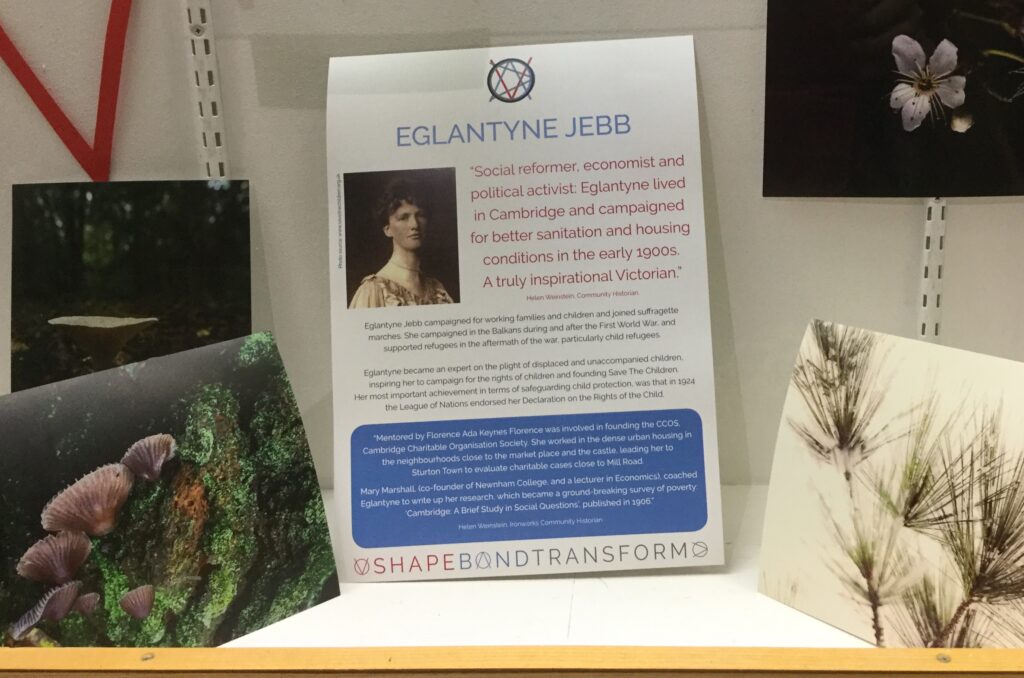

Cambridge Action for Equality 2020
Cambridge 2030 Collaborative Action for Equality was set up during 2020. It was founded by a group of individuals from private, public, voluntary and community organisations in Cambridge who came together with the collective ambition to address inequality in Cambridge. Find out more and sign up to get involved HERE.
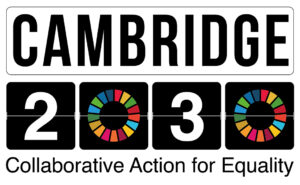
‘Our mission is to unite our community in action to fight inequality and create a healthy and prosperous city for everyone’.
Looking for more historical inspiration?
Read more about The Women Of Cambridge by Antony Carpen.
FORGE is an evolving project, sharing stories, ideas and actions together. We would love to hear from you.
Please email Ironworks artist in residence Hilary Cox Condron at hilarycoxcondron@gmail.com
Join the conversation on our Facebook page HERE
Hilary Cox Condron on Twitter @mshilarycoxSocial distancing has meant we have had to find lots of different ways to connect. The FORGE Community Gallery is another digital opportunity to share our creativity and ideas, and spread a little joy, too. If you would like to add to it, it’s really quite straight forward, there are instructions on the page – posts can be anonymous if you’d like them to be – and all posts will be monitored before it is made public. We would love you to join us there.
#ForgeCambridge #shapebondtransform
If you would like updates about the IRONWORKS public art programme and future community events, you can sign up to the Resonance-Cambridge mailing list HERE

